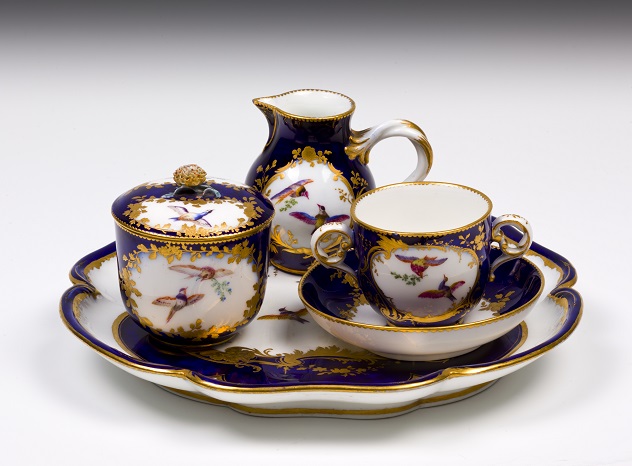Triton
Josiah Wedgwood (Burslem, Staffs. 1730 – Etruria, Staffs. 1795)
Category
Ceramics
Date
circa 1770 - 1776
Materials
Black basalt
Measurements
640 m x 270 mm x 300 mm; 17 kg (weight)
Place of origin
Etruria
Order this imageCollection
Vyne Estate, Hampshire
NT 719580.1
Summary
Black basalt, Triton, after Gian Lorenzo Bernini (1598-1680), by Wedgwood and Bentley, Etruria, Staffordshire, c. 1770-76. A black basalt figure of a triton wrestling with a dolphin, based on the colossal marble statue carved by Bernini for the centre of the Fontana del Moro at the Piazza Navona, Rome. Unmarked.
Full description
From the 1750s, small-scale seventeenth-century Continental bronze sculptures increasingly appeared in upper-class English interiors, trophies for classically educated gentlemen. Alternatively, reductions of antique and ‘modern’ – renaissance and baroque – sculpture could be purchased in Rome from various workshops including the Zoffoli family, whose work was also sold in London in the 1780s. A less expensive alternative was plaster casts coloured to resemble patinated bronze, sold by English makers, notably John Cheere and Mary Landré. Typical of this taste are two Wedgwood and Bentley black basalt figures, Neptune and Triton, at The Vyne, Hampshire. Made around 1770–6, they capitalised on a revival of interest in the work of the great Roman baroque sculptor Gianlorenzo Bernini (1598–1680). Though their sculptures were never numerous, Wedgwood and Bentley intended to revolutionise chimney garnitures by intermixing figures with their vases. The firm’s black basalt, a fine black stoneware tinted with manganese, has a lustrous sheen and unfired, powdered ‘bronze’ finish that is well suited to imitate antique metal, as well as being durable and relatively inexpensive.Exclusive models were sourced from ‘Cabinets of yr. Noble customers, which have not appeared in the shops’, or the Continent. On 9 September 1769, Wedgwood wrote to Bentley, ‘I liked much your plan of havg the Bronze figures from Rome, provided they are fine & have not been hackney’d here’. Skilled in-house figure makers, known as ‘repairers’, were required by the manufactory to take to pieces the clay, wax or plaster models for the sculptures, make intaglio moulds from the various parts, cast them separately and assemble them as hollow figures, before firing. By 1773, Wedgwood and Bentley had 23 statues listed in their ornamental catalogue, the largest being the two sculptures described here, ‘no. 5 Neptune, a Statue, from the Antique, 2 feet’ and its pair, ‘no. 6 Triton, ditto, from Bernini, 2 feet’. Both were after engravings of fountains by Bernini in a book by Paolo Alessandro Maffei, Raccolta di Statue Antiche e Moderne, published in Rome in 1704 – a copy was in the manufactory’s library. Neptune was based on a fountain figure of 1622–3 in the garden of the Villa Montalto in Rome. The triton in Bernini’s original is replaced in the ceramic version by a dolphin, perhaps inspired by a seventeenth century Italian bronze that had been on the market in London in the 1730s. Triton is based on the fountain in the Piazza Navona, Rome, known as the Fountain of the Moor, made in about 1653–5. Bronze reductions of the sculpture were available, and terracotta versions, including Bernini’s original presentation model of around 1653, may also have been available in Rome for study by agents of London’s plaster-figure makers In an 1842 inventory of The Vyne, Neptune and Triton appear in the blue-painted neoclassical ‘Staircase & Passage’ created in 1769–71 by the house’s owner, John Chute, as ‘2 Bronze figures (Tritons) / A 18 inch Vase / 2 Figures with Lamps’. All five items, made of black basalt, survive, some having remained in the same location since 1776. They may have been acquired by Chute (1701–76), an amateur architect, connoisseur and antiquary, who could have seen Bernini’s originals when in Italy with Horace Walpole in the 1740s (see page 82). Since at least 1908, these two figures have been in the sixteenth-century Oak Gallery, displayed alongside bronzes purchased in the 1840s by William Lyde Wiggett Chute (1800–79). Adapted from Patricia F. Ferguson, Ceramics: 400 Years of British Collecting in 100 Masterpieces, Philip Wilson Publishers, 2016.
Provenance
Possibly acquired by John Chute (1701–76), who may have seen Bernini’s statue during a visit to Italy with Horace Walpole in the 1740s; listed in 1842 Vyne inventory as ‘2 Bronze figures (Tritons) / A 18 inch Vase / 2 Figures with Lamps’, located in ‘Staircase & Passage’, all five items survive, some having remained in the same location since 1776; in Oak Gallery since at least 1908, displayed alongside bronzes purchased in the 1840s by William Lyde Wiggett Chute (1800–79); gifted to the National Trust along with The Vyne and the contents of the property under the bequest of Sir Charles Chute in 1956.
Makers and roles
Josiah Wedgwood (Burslem, Staffs. 1730 – Etruria, Staffs. 1795), maker after Gian Lorenzo Bernini (Naples 1598 – Rome 1680), sculptor
References
Ferguson 2016: Patricia F. Ferguson, Ceramics: 400 Years of British Collecting in 100 Masterpieces, Philip Wilson Publishers, 2016, pp. 40-1 Gallagher 2020: Brian D. Gallagher (ed.), Classic Black, The Basalt Sculpture of Wedgwood and His Contemporaries, exh.cat., The Mint Museum, Charlotte, North Carolina 2020, pp. 126-7, no. 34












